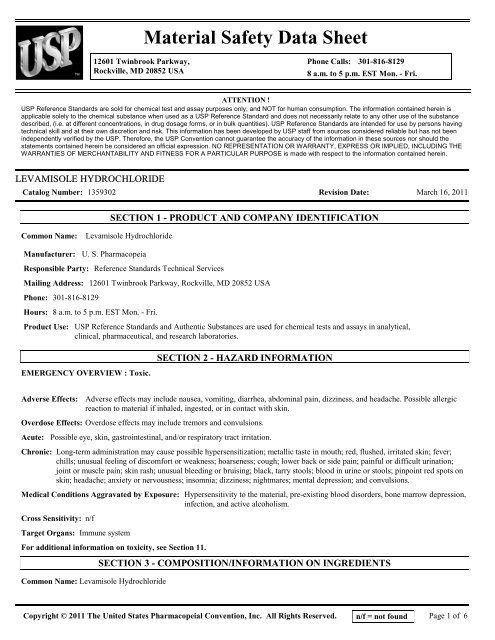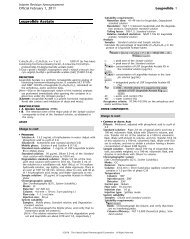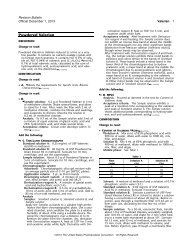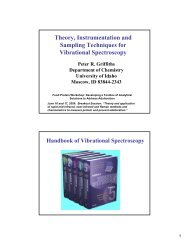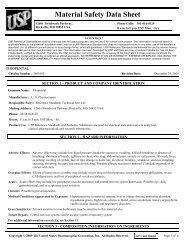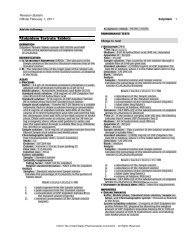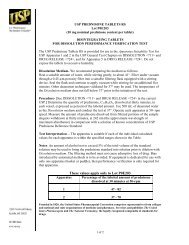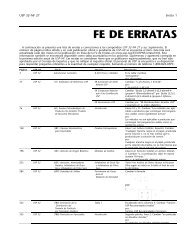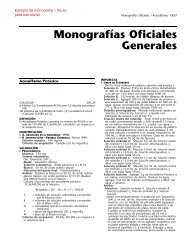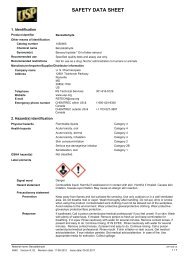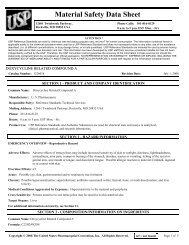rptEntry Form Print - US Pharmacopeial Convention
rptEntry Form Print - US Pharmacopeial Convention
rptEntry Form Print - US Pharmacopeial Convention
Create successful ePaper yourself
Turn your PDF publications into a flip-book with our unique Google optimized e-Paper software.
12601 Twinbrook Parkway,<br />
Rockville, MD 20852 <strong>US</strong>A<br />
Material Safety Data Sheet<br />
Phone Calls: 301-816-8129<br />
8 a.m. to 5 p.m. EST Mon. - Fri.<br />
ATTENTION !<br />
<strong>US</strong>P Reference Standards are sold for chemical test and assay purposes only, and NOT for human consumption. The information contained herein is<br />
applicable solely to the chemical substance when used as a <strong>US</strong>P Reference Standard and does not necessarily relate to any other use of the substance<br />
described, (i.e. at different concentrations, in drug dosage forms, or in bulk quantities). <strong>US</strong>P Reference Standards are intended for use by persons having<br />
technical skill and at their own discretion and risk. This information has been developed by <strong>US</strong>P staff from sources considered reliable but has not been<br />
independently verified by the <strong>US</strong>P. Therefore, the <strong>US</strong>P <strong>Convention</strong> cannot guarantee the accuracy of the information in these sources nor should the<br />
statements contained herein be considered an official expression. NO REPRESENTATION OR WARRANTY, EXPRESS OR IMPLIED, INCLUDING THE<br />
WARRANTIES OF MERCHANTABILITY AND FITNESS FOR A PARTICULAR PURPOSE is made with respect to the information contained herein.<br />
LEVAMISOLE HYDROCHLORIDE<br />
Catalog Number: 1359302 Revision Date: March 16, 2011<br />
Common Name: Levamisole Hydrochloride<br />
Manufacturer: U. S. Pharmacopeia<br />
SECTION 1 - PRODUCT AND COMPANY IDENTIFICATION<br />
Responsible Party: Reference Standards Technical Services<br />
Mailing Address: 12601 Twinbrook Parkway, Rockville, MD 20852 <strong>US</strong>A<br />
Phone: 301-816-8129<br />
Hours: 8 a.m. to 5 p.m. EST Mon. - Fri.<br />
Product Use: <strong>US</strong>P Reference Standards and Authentic Substances are used for chemical tests and assays in analytical,<br />
clinical, pharmaceutical, and research laboratories.<br />
EMERGENCY OVERVIEW : Toxic.<br />
SECTION 2 - HAZARD INFORMATION<br />
Adverse Effects: Adverse effects may include nausea, vomiting, diarrhea, abdominal pain, dizziness, and headache. Possible allergic<br />
reaction to material if inhaled, ingested, or in contact with skin.<br />
Overdose Effects: Overdose effects may include tremors and convulsions.<br />
Acute: Possible eye, skin, gastrointestinal, and/or respiratory tract irritation.<br />
Chronic: Long-term administration may cause possible hypersensitization; metallic taste in mouth; red, flushed, irritated skin; fever;<br />
chills; unusual feeling of discomfort or weakness; hoarseness; cough; lower back or side pain; painful or difficult urination;<br />
joint or muscle pain; skin rash; unusual bleeding or bruising; black, tarry stools; blood in urine or stools; pinpoint red spots on<br />
skin; headache; anxiety or nervousness; insomnia; dizziness; nightmares; mental depression; and convulsions.<br />
Medical Conditions Aggravated by Exposure: Hypersensitivity to the material, pre-existing blood disorders, bone marrow depression,<br />
infection, and active alcoholism.<br />
Cross Sensitivity: n/f<br />
Target Organs: Immune system<br />
For additional information on toxicity, see Section 11.<br />
Common Name: Levamisole Hydrochloride<br />
SECTION 3 - COMPOSITION/INFORMATION ON INGREDIENTS<br />
Copyright © 2011 The United States <strong>Pharmacopeial</strong> <strong>Convention</strong>, Inc. All Rights Reserved. n/f = not found Page 1 of 6
LEVAMISOLE HYDROCHLORIDE<br />
Catalog Number: 1359302 Revision Date: March 16, 2011<br />
<strong>Form</strong>ula: C11H12N2S . HCl<br />
Synonym: n/f<br />
Chemical Name: Imidazo[2,1-b]thiazole, 2,3,5,6-tetrahydro-6-phenyl-, monohydrochloride, (S)-<br />
CAS: 16595-80-5<br />
RTECS Number: NJ5960000<br />
Chemical Family: Imidazo-thiazole derivative<br />
Therapeutic Category: Biological response modifier; anthelmintic<br />
Composition: Pure material<br />
Inhalation: May cause irritation. Remove to fresh air.<br />
Eye: May cause irritation. Flush with copious quantities of water.<br />
SECTION 4 - FIRST AID MEASURES<br />
Skin: May cause irritation. Flush with copious quantities of soap and water.<br />
Ingestion: May cause irritation and toxicity. Flush out mouth with water. This material is rapidly absorbed from the gastrointestinal<br />
tract.<br />
General First Aid Procedures: Remove from exposure. Remove contaminated clothing. For treatment advice, seek guidance from an<br />
occupational health physician or other licensed health-care provider familiar with workplace chemical<br />
exposures. In the United States, the national poison control center phone number is 1-800-222-1222. If<br />
person is not breathing, give artificial respiration. If breathing is difficult, give oxygen if available.<br />
Persons developing serious hypersensitivity (anaphylactic) reactions must receive immediate medical<br />
attention.<br />
Note to Physicians<br />
Overdose Treatment: Treatment of levamisole overdose should be symptomatic and supportive and may include the following:<br />
1.Administer activated charcoal as a slurry.<br />
2.Monitor serial CBC with differential.<br />
3.For severe neutropenia, administer a colony stimulating factor (eg, filgrastim, sargramostism).<br />
4.Transfusions as needed for severe thrombocytopenia or bleeding.<br />
5.Treat patients with seizures with IV benzodiazepines; barbiturates or propofol may be needed if seizures<br />
persist or recur.<br />
6.Patients with levamisole-induced leukoencephalopathy (LILE) have been treated with corticosteroids.<br />
[Meditext 2011]<br />
SECTION 5 - FIREFIGHTING MEASURES<br />
Extinguisher Media: Water spray, dry chemical, carbon dioxide, or foam as appropriate for surrounding fire and materials.<br />
Fire and Explosion Hazards: This material is assumed to be combustible. As with all dry powders, it is advisable to ground mechanical<br />
equipment in contact with dry material to dissipate the potential buildup of static electricity.<br />
Firefighting Procedures: As with all fires, evacuate personnel to a safe area. Firefighters should use self-contained breathing<br />
equipment and protective clothing.<br />
SECTION 6 - ACCIDENTAL RELEASE MEASURES<br />
Spill Response: Wear approved respiratory protection, chemically compatible gloves, and protective clothing. Wipe up spillage or<br />
collect spillage using a high-efficiency vacuum cleaner. Avoid breathing dust. Place spillage in appropriately labeled<br />
container for disposal. Wash spill site.<br />
SECTION 7 - HANDLING AND STORAGE<br />
Handling: As a general rule, when handling <strong>US</strong>P Reference Standards, avoid all contact and inhalation of dust, mists, and/or vapors<br />
Copyright © 2011 The United States <strong>Pharmacopeial</strong> <strong>Convention</strong>, Inc. All Rights Reserved. n/f = not found Page 2 of 6
LEVAMISOLE HYDROCHLORIDE<br />
Catalog Number: 1359302 Revision Date: March 16, 2011<br />
Storage: Store in tight container as defined in the <strong>US</strong>P-NF. This material should be handled and stored per label instructions to ensure<br />
product integrity.<br />
SECTION 8 - EXPOSURE CONTROL / PERSONAL PROTECTION<br />
Engineering Controls: Airborne exposure should be controlled primarily by engineering controls such as general dilution ventilation,<br />
local exhaust ventilation, or process enclosure. Local exhaust ventilation is generally preferred to general<br />
exhaust because it can control the contaminant at its source, preventing dispersion into the work area. An<br />
industrial hygiene survey involving air monitoring may be used to determine the effectiveness of engineering<br />
controls. Effectiveness of engineering controls intended for use with highly potent materials should be assessed<br />
by use of nontoxic surrogate materials.<br />
Local exhaust ventilation such as a laboratory fume hood or other vented enclosure is recommended,<br />
particularly for grinding, crushing, weighing, or other dust-generating procedures.<br />
Respiratory Protection: Where respirators are deemed necessary to reduce or control occupational exposures, use NIOSH-approved<br />
respiratory protection and have an effective respirator program in place (applicable U.S. regulation OSHA 29<br />
CFR 1910.134).<br />
Gloves: Chemically compatible. For handling solutions, ensure that the glove material is protective against the solvent being used. Use<br />
handling practices that minimize direct hand contact. Employees who are sensitive to natural rubber (latex) should use nitrile<br />
or other synthetic nonlatex gloves. Use of powdered latex gloves should be avoided due to the risk of latex allergy.<br />
Eye Protection: Safety glasses with sideshields are recommended. Face shields or goggles may be required if splash potential exists or<br />
if corrosive materials are present. Approved eye protection (e.g., bearing the ANSI Z87 or CSA stamp) is preferred.<br />
Maintain eyewash facilities in the work area.<br />
Protective Clothing: For handling of laboratory scale quantities, a cloth lab coat is recommended. Where significant quantities are<br />
handled, work clothing may be necessary to prevent take-home contamination.<br />
Exposure Limits: n/f<br />
SECTION 9 - PHYSICAL AND CHEMICAL PROPERTIES<br />
Properties as indicated on the MSDS are general and not necessarily specific to the <strong>US</strong>P Reference Standard Lot provided.<br />
Appearance and Odor: White or almost white crystalline powder.<br />
Odor Threshold: n/f<br />
Melting Range: 224 - 231° C<br />
Boiling Point: n/f<br />
Evaporation Rate: n/f<br />
Vapor Pressure: n/f<br />
Vapor Density: n/f<br />
Specific Gravity: n/f<br />
associated with the material. Clean equipment and work surfaces with suitable detergent or solvent after use. After removing<br />
gloves, wash hands and other exposed skin thoroughly.<br />
pH: 3.0 to 4.5 (5% solution)<br />
Flash Point: n/f<br />
Autoignition Temperature: 570° C<br />
Upper Flammability Limit: n/f<br />
Lower Flammability Limit: n/f<br />
Solubility in Water: Freely soluble<br />
Fat Solubility:
LEVAMISOLE HYDROCHLORIDE<br />
Catalog Number: 1359302 Revision Date: March 16, 2011<br />
Partition Coefficient: n-octanol/water: log P = 1.84<br />
Percent Volatile: n/f<br />
Reactivity in Water: n/f<br />
Explosive Properties: n/f<br />
Oxidizing Properties: n/f<br />
<strong>Form</strong>ula: C11H12N2S . HCl<br />
Molecular Weight: 240.75<br />
Copyright © 2011 The United States <strong>Pharmacopeial</strong> <strong>Convention</strong>, Inc. All Rights Reserved. n/f = not found Page 4 of 6
LEVAMISOLE HYDROCHLORIDE<br />
Catalog Number: 1359302 Revision Date: March 16, 2011<br />
Conditions to Avoid: Avoid exposure to light and moisture.<br />
Incompatibilities: Oxidizing agents and strong bases.<br />
Decomposition Products: When heated to decomposition, material emits very toxic fumes of NOx, SOx, and HCl. Emits toxic fumes<br />
under fire conditions.<br />
Stable? Yes<br />
Oral Rat: LD50: 180 mg/kg<br />
Oral Mouse: LD50: 223 mg/kg<br />
Other Toxicity Data: n/f<br />
Irritancy Data: n/f<br />
Corrosivity: n/f<br />
Sensitization Data: n/f<br />
Listed as a Carcinogen by:<br />
SECTION 11 - TOXICOLOGICAL PROPERTIES<br />
NTP: No IARC: No OSHA: No<br />
Other Carcinogenicity Data: Chronic administration of high doses (25 mg/kg) in New Zealand Black mice increased the rate and<br />
intensity of spontaneous lymphomas.<br />
Mutagenicity Data: Levamisole was not found to be mutagenic in dominant lethal studies in male and female mice, in an Ames test,<br />
and in a study to detect chromosomal aberrations in cultured peripheral human lymphocytes.<br />
Reproductive and Developmental Effects: Fertility and perinatal studies in the rat indicated some decrease in implantation at 120 and<br />
240 mg levels and some decrease in viability over 60 mg per kg. No defect increases were<br />
found, but some growth retardation was found at 120 mg per kg. In pregnant rabbits given<br />
90 mg/kg/day, an increase in fetal mortality occurred but no increase in congenital<br />
anomalies.<br />
Ecological Information: n/f<br />
SECTION 12 - ECOLOGICAL INFORMATION<br />
SECTION 13 - DISPOSAL CONSIDERATIONS<br />
Disposal: Dispose of waste in accordance with all applicable Federal, State, and local laws.<br />
SECTION 14 -TRANSPORT INFORMATION<br />
Shipping Name: Toxic solid, organic, n.o.s. (Levamisole Hydrochloride)<br />
Class: 6.1<br />
UN Number: UN2811<br />
Packing Group: III<br />
Hazardous Polymerization? No<br />
Additional Transport Information: n/f<br />
U.S. Regulatory Information: n/f<br />
International Regulatory Information: EINECS # 240-654-6<br />
SECTION 10 - STABILITY AND REACTIVITY<br />
SECTION 15 - REGULATORY INFORMATION<br />
Copyright © 2011 The United States <strong>Pharmacopeial</strong> <strong>Convention</strong>, Inc. All Rights Reserved. n/f = not found Page 5 of 6
LEVAMISOLE HYDROCHLORIDE<br />
Catalog Number: 1359302 Revision Date: March 16, 2011<br />
Revision: 16-Mar-11<br />
Previous Revision Date: 09-Feb-05<br />
SECTION 16 - OTHER INFORMATION<br />
Copyright © 2011 The United States <strong>Pharmacopeial</strong> <strong>Convention</strong>, Inc. All Rights Reserved. n/f = not found Page 6 of 6


